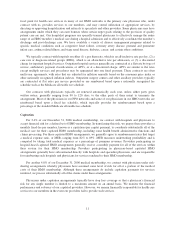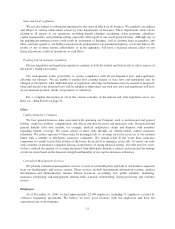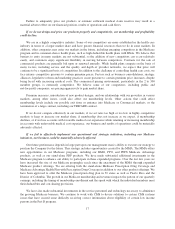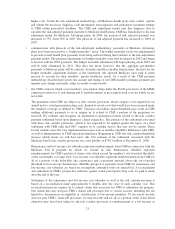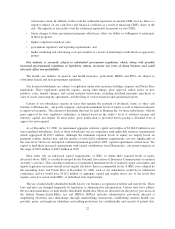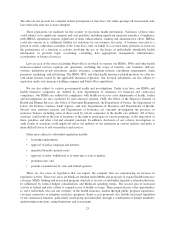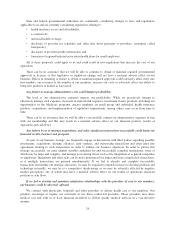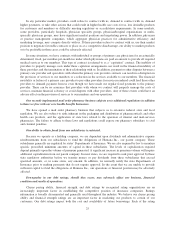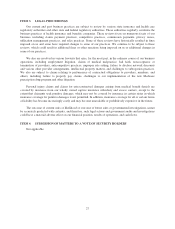Humana 2006 Annual Report Download - page 30
Download and view the complete annual report
Please find page 30 of the 2006 Humana annual report below. You can navigate through the pages in the report by either clicking on the pages listed below, or by using the keyword search tool below to find specific information within the annual report.The growth of our Medicare business is an important part of our business strategy. Any failure to achieve
this growth may have a material adverse effect on our financial position, results of operations or cash flows. In
addition, the expansion of our Medicare business in relation to our other businesses may intensify the risks to us
inherent in the Medicare business, which are described elsewhere in this document. These expansion efforts may
result in less diversification of our revenue stream.
Additionally, our strategy includes the growth of our Commercial segment business, with emphasis on our
ASO and individual products, introduction of new products and benefit designs, including our Smart, consumer-
choice products such as HSAs as well as the adoption of new technologies and the integration of acquired
businesses and contracts.
There can be no assurance that we will be able to successfully implement our operational and strategic
initiatives that are intended to position us for future growth or that the products we design will be accepted or
adopted in the time periods assumed. Failure to implement this strategy may result in a material adverse effect on
our financial position, results of operations and cash flows.
If we fail to properly maintain the integrity of our data, to strategically implement new information
systems, or to protect our proprietary rights to our systems, our business could be materially adversely
affected.
Our business depends significantly on effective information systems and the integrity and timeliness of the
data we use to run our business. Our business strategy involves providing members and providers with easy to
use products that leverage our information to meet their needs. Our ability to adequately price our products and
services, provide effective and efficient service to our customers, and to timely and accurately report our
financial results depends significantly on the integrity of the data in our information systems. As a result of our
past and on-going acquisition activities, we have acquired additional information systems. We have been taking
steps to reduce the number of systems we operate, have upgraded and expanded our information systems
capabilities, and are gradually migrating existing business to fewer systems. Our information systems require an
ongoing commitment of significant resources to maintain, protect and enhance existing systems and develop new
systems to keep pace with continuing changes in information processing technology, evolving industry and
regulatory standards, and changing customer preferences. If the information we rely upon to run our businesses
was found to be inaccurate or unreliable or if we fail to maintain effectively our information systems and data
integrity, we could have operational disruptions, have problems in determining medical cost estimates and
establishing appropriate pricing, have customer and physician and other health care provider disputes, have
regulatory or other legal problems, have increases in operating expenses, lose existing customers, have difficulty
in attracting new customers, or suffer other adverse consequences.
We depend on independent third parties for significant portions of our systems-related support, equipment,
facilities, and certain data, including data center operations, data network, voice communication services and
pharmacy data processing. This dependence makes our operations vulnerable to such third parties’ failure to
perform adequately under the contract, due to internal or external factors. A change in service providers could
result in a decline in service quality and effectiveness or less favorable contract terms which could adversely
affect our operating results.
We rely on our agreements with customers, confidentiality agreements with employees, and our trade
secrets and copyrights to protect our proprietary rights. These legal protections and precautions may not prevent
misappropriation of our proprietary information. In addition, substantial litigation regarding intellectual property
rights exists in the software industry. We expect software products to be increasingly subject to third-party
infringement claims as the number of products and competitors in this area grows.
Our business plans also include becoming a quality e-business organization by enhancing interactions with
customers, brokers, agents, and other stakeholders through web-enabling technology. Our strategy includes sales
and distribution of health benefit products through the Internet, and implementation of advanced self-service
capabilities, for internal and external stakeholders.
18





